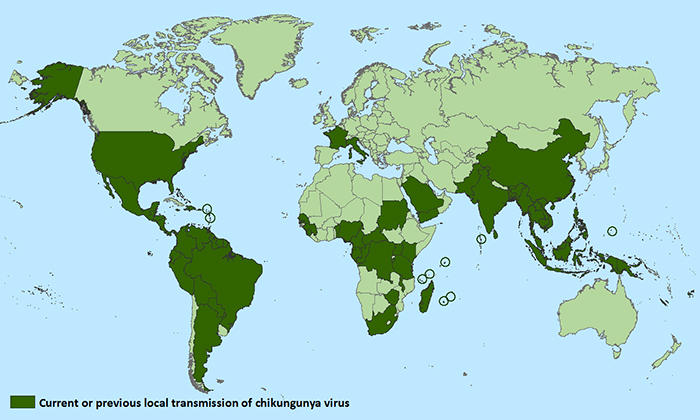History of the Condition
Though not quite well-known among the general audience, Chikungunya has recently become the scourge of humanity, as it is one of the diseases that no treatment can be provided so far and that triggers the eruption of vast epidemics. The disorder manifests itself in a fever. The virus, in its turn, is transmitted by mosquitoes inhabiting Africa, Asia, and some parts of South America. It would be wrong to believe that all mosquito bites are deadly; only the “Aedes spp., predominantly Aedes aegypti and Ae. albopictus” (Staples, Hills, & Powers, 2016, par. 2) species can be viewed as possible carriers of the virus.
The virus was first detected and described in the 1950s in Africa, disappearing shortly afterward, only to reemerge in 2004 in Kenya. The progress of the virus has been occurring at an incredibly fast pace since then, taking numerous lives.
In 2007, the virus was imported to Europe, with the following epidemic erupting in Italy. As the outbreak ended, it became obvious that the virus developed the ability to locate and transfer to new ecological niches, therefore, endangering an increasingly large number of people (Staples, Hills, & Powers, 2009). Given the speed of virus development and transfer, the provision of the corresponding prevention measures must be viewed as a necessity.
Epidemiological Data
When considering the outbreaks of the virus, one must admit that it does not have a specific geographical location that can be defined as the nidus, i.e., the area that it comes from, Chikungunya outbreaks were first spotted in Africa and Asia, whereas later on, the disease spread to Europe and the American continents. At present, the virus has spread across the South American continent and the United States (see Fig. 1).

As a rule, CHIKV triggers rapid and large outbreaks, affecting a significant part (1/3-3/4) of the population inhabiting the area. Although the disease remains a tangible threat in any environment of the target areas, rainy days create especially favorable circumstances for the people in the vicinity to contract the disease. However, in the non-tropical areas, e.g., Africa, the disease has been an especially serious threat during the dry seasons (Centers for Disease Control and Prevention, 2016b).
Determining the population that is likely to be affected by the virus, one must admit that children and adults alike should take precaution measures as both age groups are in jeopardy once exposed to the threat of contracting CHIKV. It is quite remarkable, though, that the instances of CHIKV contraction have been registered mostly among travelers, whereas the residents remain the minority of the CHIKV victims.
Application of the Levels of Prevention According to the CDC or the NIH and Based on Healthy People 2020 Goals
At first glance, it might seem that the process of addressing the disease should be viewed from the secondary level. Indeed, seeing that the disease is caused by mosquitoes, there is hardly anything to do to stop the insects from biting people. However, an overview of the recent treatment methods shows that there is no cure for Chikungunya at present. Therefore, addressing the problem from the viewpoint of treatment is not a possibility at present.
Consequently, the issue must be resolved at the primary level. Instead of considering mosquitoes as the root cause, though, one should view the carelessness and the lack of awareness that tourists display when visiting the endangered areas as the key problem. Consequently, it is imperative to carry out a large awareness campaign among the target population, stressing the significance of precaution measures.
The identified approach aligns with the Healthy People 2020 goals: according to the latter, the provision of information about the current and future health concerns tops the range of objectives to be accomplished in the nearest future. More importantly, the application of the latest informational technologies as the tools for transferring data and reaching out to all members of the target population must be viewed as an opportunity. In other words, all types of media, including the traditional and especially modern ones must be incorporated into the process of promoting knowledge on the issue of Chikungunya in the community.
Enhancing people’s awareness on the subject matter, therefore, should be viewed as the primary tool for preventing the epidemics of Chikungunya to grow and capture larger areas. Moreover, by shedding light on the subject matter, one is likely to promote further research that may eventually result in locating the methods of treatment. As for now, it is important to make sure that the people living in the identified areas or visiting them as tourists should take the necessary precaution measures.
Detailing the instructions for the disease prevention, one should mention the use of the corresponding repellents, sleeping under a mosquito net, and consider wearing shirts with long sleeves, as well as long trousers, as the means of securing oneself from mosquito bites (Centers for Disease Control and Prevention, 2016b).
Reference List
Centers for Disease Control and Prevention (2016a). Geographic distribution. Web.
Centers for Disease Control and Prevention. (2016b). Prevention. Web.
Staples, J. E., Hills, S. L., & Powers, A. M. (2009). Chikungunya fever: An epidemiological review of a re-emerging infectious disease. Clinical Infectious Diseases, 49(6), 942-948.
Staples, J. E., Hills, S. L., & Powers, A. M. (2016). Infectious diseases related to travel. Web.